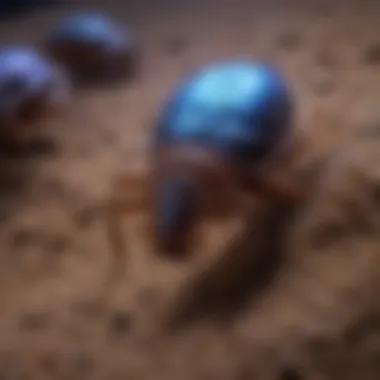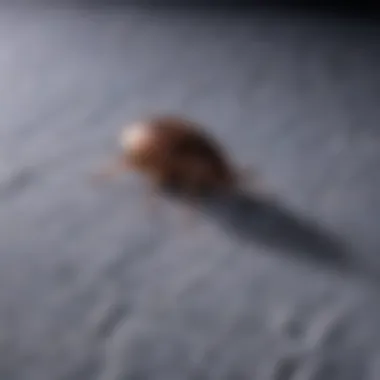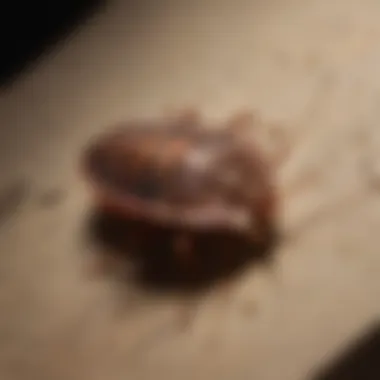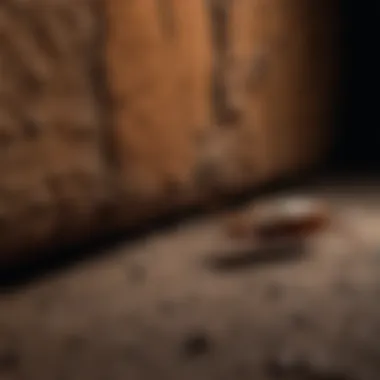Unveiling the Power of Black Light for Bed Bug Detection


Rock and Fossil Identification
In the realm of bed bug detection, the utilization of black light serves as a cutting-edge tool to uncover these elusive pests. Understanding the key characteristics of bed bugs that can be illuminated by black light is essential. Bed bugs emit a distinct fluorescence when exposed to certain wavelengths of ultraviolet light, making their presence detectable in dark or hidden areas that are challenging to inspect with the naked eye. The unique glow emitted by these nocturnal pests is a crucial identification feature for effective pest management efforts.
Geological Insights
Collecting Tips and Techniques
When utilizing black light for bed bug detection, adopting best practices is key to achieving accurate results. Locating prime habitats for bed bugs, such as bedding seams, furniture crevices, and electrical outlets, is crucial for a thorough inspection. Safely extracting specimens or evidence of bed bugs using tools like magnifying glasses, tweezers, and specimen containers ensures proper identification and containment of potential infestations. By following these techniques, collectors can enhance their detection abilities and contribute to more efficient pest management strategies.
Preservation and Display
Preserving the integrity of collected bed bug specimens is essential for accurate identification and data analysis. Employing techniques such as proper labeling, storage in airtight containers, and maintaining temperature-controlled environments helps prevent contamination and degradation of samples. Creative display ideas, such as using UV light to showcase the fluorescent properties of bed bugs, can offer educational insights into their biology and behavior. By embracing innovative preservation methods and thoughtful display approaches, collectors can elevate the presentation of their findings and contribute to the advancement of pest detection research.
Introduction to Black Light for Bed Bug Detection
In the realm of pest control and detection, black light technology stands out as a sophisticated tool for uncovering the presence of bed bugs in diverse settings. As we delve into the nuances of using black light for bed bug detection, it becomes evident that this method holds significant promise in identifying infestations. The ability to harness the power of black light not only amplifies the efficiency of pest control measures but also offers a non-invasive approach to pinpointing bed bug habitats. By shedding light on the hidden world of bed bugs through fluorescence, black light technology provides a unique perspective on pest management strategies.
Understanding Black Light Technology
Definition and Characteristics of Black Light
The Definition and Characteristics of Black Light encompass its unique ability to emit ultraviolet (UV) radiation in the 320-400 nanometer range, with a special focus on the 365nm wavelength that optimally illuminates fluorescent substances. This distinct feature of black light makes it an indispensable tool for detecting biological traces invisible to the naked eye. By leveraging the properties of black light, practitioners in pest control can enhance their efficiency and accuracy in identifying bed bug infestations.
UV Spectrum and Wavelengths
The UV Spectrum and Wavelengths associated with black light play a pivotal role in its efficacy for bed bug detection. Operating within the UVA range, typically 320-400nm, black light provides a precise wavelength that triggers fluorescence in bed bug excrement and bodily secretions. This targeted approach aids in isolating potential infestation sites with higher precision, contributing to the overall success of pest control interventions.
Fluorescence Mechanism
The Fluorescence Mechanism underpinning black light technology involves the absorption of UV energy by fluorescent molecules, leading to their subsequent re-emission at longer wavelengths within the visible spectrum. This phenomenon allows bed bug-related substances to emit a visible glow under black light, facilitating their detection against various surfaces. Leveraging the fluorescence mechanism of black light enables pest control professionals to uncover hidden infestation signs with enhanced clarity and accuracy.
Benefits of Using Black Light for Pest Control
The Benefits of Using Black Light for Pest Control are multifaceted, starting with its status as a non-invasive detection method that minimizes disturbances while conducting inspections. Additionally, the efficiency in identifying bed bug presence through black light illumination streamlines the detection process, allowing for rapid and accurate assessment of infestation levels. The versatility of black light in different environments further enhances its appeal, as it can adapt to various settings and surface types, providing pest control experts with a versatile tool for comprehensive inspections.
Overview of Bed Bugs and Infestation Signs
Behavior and Habits of Bed Bugs
The Behavior and Habits of Bed Bugs elucidate the elusive nature of these pests, known for their nocturnal feeding habits and preference for hiding in cracks and crevices near sleeping areas. Understanding these behavioral patterns is crucial for effective detection and eradication of bed bug populations. By delving into the intricacies of bed bug behavior, pest control professionals can anticipate infestation trends and strategically target infested areas for optimal results.


Common Signs of Bed Bug Infestations
Common Signs of Bed Bug Infestations serve as red flags for identifying potential breeding grounds and harborage sites within indoor environments. From distinct bite patterns on human skin to the presence of reddish-brown fecal spots on bedding, these signs offer valuable clues for detecting bed bug scenarios. Recognizing and interpreting these common indicators empower individuals to take proactive measures in mitigating bed bug infestations before they escalate.
Impact on Health and Environment
The Impact on Health and Environment resulting from bed bug infestations extends beyond physical discomfort to encompass psychological distress and financial burdens on affected individuals. Moreover, the environmental implications of widespread bed bug infestations pose challenges for biodiversity and ecosystem equilibrium. Addressing the health and environmental consequences of bed bugs underscores the importance of early detection and intervention to prevent further repercussions on human well-being and ecological sustainability.
Using Black Light Equipment for Bed Bug Detection
In this article, the focus on Using Black Light Equipment for Bed Bug Detection is paramount as it establishes the foundational tools needed for accurate pest identification. Understanding the significance of proper equipment selection and utilization is crucial in the successful detection of bed bugs. By delving into specific elements, benefits, and considerations of Using Black Light Equipment for Bed Bug Detection, we can enhance our ability to combat infestations effectively.
Types of Black Light Devices
Handheld UV Flashlights
Handheld UV flashlights play a crucial role in bed bug detection due to their portability and focused UV light emission. Their compact design allows for easy maneuverability, ensuring thorough inspections in various settings. The key characteristic of Handheld UV Flashlights lies in their ability to reveal fluorescent markers left by bed bugs, aiding in pinpointing infestation hotspots. Despite their efficiency, Handheld UV Flashlights may have limited coverage areas, requiring meticulous scanning to detect hidden pests.
Portable Black Light Lamps
Portable Black Light Lamps offer a broader spectrum of UV light, catering to larger inspection areas with a more intense light source. The key characteristic of these lamps is their ability to illuminate a wide surface area, making them ideal for detecting bed bugs in open spaces or furniture. However, the intensity of Portable Black Light Lamps may diminish over time, necessitating periodic bulb replacement for consistent performance.
Integrated Detection Systems
Integrated Detection Systems combine UV light technology with advanced sensors and imaging capabilities, streamlining the detection process. Their seamless integration into existing pest control systems enhances overall efficiency and accuracy in identifying bed bug presence. The unique feature of Integrated Detection Systems lies in their automated detection algorithms, reducing human error and providing detailed reports for pest management professionals. Despite their effectiveness, Integrated Detection Systems may require regular maintenance and calibration to ensure optimal functionality.
Optimal Conditions for Black Light Inspections
Dim Lighting Requirements
Dim lighting requirements are essential for effective black light inspections as excessive ambient light can diminish the fluorescence of bed bug markers. The key characteristic of dim lighting lies in its ability to enhance the visibility of fluorescent patterns, optimizing detection outcomes. However, complete darkness may impede thorough inspections, necessitating a balance between light levels to achieve accurate results.
Target Areas for Bed Bug Detection
Identifying target areas for bed bug detection is crucial in focusing inspection efforts on commonly infested locations. The key characteristic of targeting specific areas lies in maximizing detection precision and efficiency, ensuring thorough coverage of potential hiding spots. However, overlooking less visible areas may lead to undetected infestations, highlighting the importance of comprehensive inspection protocols.
Precautions for Accurate Results
Taking precautions for accurate results is key to minimizing false positives and ensuring reliable detection outcomes. The key characteristic of precautionary measures lies in reducing external interference that may affect black light inspections, such as reflective surfaces or contamination. Implementing strict protocols and standardized procedures can enhance the consistency and validity of inspection results, safeguarding against misinterpretations or oversights.
Techniques for Black Light Examination


Systematic Room Scanning
Systematic room scanning involves methodical inspection patterns to cover all surfaces and potential bed bug habitats. The key characteristic of systematic scanning is its systematic approach to ensure comprehensive coverage and systematic mapping of fluorescent patterns. However, time-intensive scanning processes may prolong inspection durations, requiring diligent execution for thorough detection outcomes.
Focusing on Bedding and Furniture
Prioritizing bedding and furniture inspections is crucial as these areas are primary hiding spots for bed bugs. The key characteristic of focusing on specific furnishings lies in targeting high-risk locations where bed bug activity is most prevalent, enhancing detection accuracy. However, narrow focus areas may lead to overlooking less obvious infestation sites, emphasizing the importance of holistic inspection practices.
Interpreting Fluorescent Patterns
Interpreting fluorescent patterns requires keen observation and understanding of bed bug behavioral markers under UV light. The key characteristic of interpreting these patterns lies in discerning between ordinary stains and genuine bed bug traces, guiding accurate identification. However, misinterpretation of patterns can result in false alarms or missed infestations, underscoring the need for professional training and ongoing skill development.
Enhancing Bed Bug Detection with Black Light
In the realm of pest control, the topic of 'Enhancing Bed Bug Detection with Black Light' plays a pivotal role in this article focused on the innovative use of black light for identifying bed bug infestations. Black light technology offers a non-invasive method that can augment traditional pest detection practices. By incorporating black light into pest control strategies, professionals can enhance their ability to pinpoint bed bug presence accurately. This section delves into the specific elements that make the integration of black light indispensable in the endeavor to combat bed bug infestations.
Combining Black Light with Other Detection Methods
Visual Inspections
Visual inspections serve as a fundamental aspect of bed bug detection when combined with black light technology. The meticulous examination of areas prone to infestation coupled with the revealing properties of black light allows inspectors to identify not only current infestations but also potential breeding grounds. Visual inspections offer a hands-on and detailed approach that, complemented by black light, increases the efficiency and accuracy of bed bug detection.
Use of Traps and Monitors
Implementing traps and monitors alongside black light detection amplifies the comprehensive nature of pest control measures. Traps and monitors provide a proactive stance against bed bugs by capturing and monitoring their activity. When integrated with black light technology, these devices create a robust detection system that alerts users to the presence of bed bugs, enabling timely intervention.
Professional Pest Control Assistance
Engaging professional pest control services for bed bug management is further enhanced when supplemented with black light utilization. Pest control experts bring specialized knowledge and experience to the table, optimizing the use of black light for accurate detection. Their expertise ensures that black light technology is applied effectively and efficiently in detecting and eradicating bed bug infestations.
Maintenance and Calibration of Black Light Tools
Cleaning Procedures for Optimal Performance
Maintaining cleanliness and ensuring proper upkeep of black light devices are essential for reliable performance. Regular cleaning procedures not only prolong the lifespan of the equipment but also guarantee the accuracy of detection. By adhering to specific cleaning protocols, users can maximize the efficacy of black light tools in identifying bed bug presence.
Checking Battery and Bulb Functionality
Checking the functionality of batteries and bulbs in black light devices is crucial for uninterrupted operation. A regular inspection of these components prevents unexpected breakdowns during detection processes. Ensuring that batteries are charged and bulbs are functional guarantees seamless utilization of black light technology in bed bug detection.
Regular Testing for Accuracy


Conducting routine tests to verify the accuracy of black light devices is imperative for reliable results. Regular testing procedures involve simulating detection scenarios to confirm the proper functioning of the equipment. By integrating regular testing into maintenance routines, users can uphold the effectiveness of black light tools in identifying bed bugs.
Educational Resources and Training Programs
Online Guides and Videos
Accessing online guides and instructional videos provides valuable insights into utilizing black light for bed bug detection. These resources offer step-by-step instructions and practical demonstrations, aiding users in mastering the art of identifying bed bug infestations accurately. Online guides and videos serve as comprehensive educational tools for enhancing proficiency in black light detection.
Certified Bed Bug Detection Courses
Enrolling in certified bed bug detection courses equips professionals with specialized knowledge in utilizing black light technology effectively. These courses delve deep into the science of bed bug detection and provide hands-on training to hone detection skills. By pursuing certified courses, individuals can elevate their expertise in integrating black light for enhanced pest control practices.
Industry Expert Consultations
Seeking guidance from industry experts in the field of pest control offers valuable insights into optimizing black light technology for bed bug detection. Consulting with experts allows individuals to leverage their experience and expertise for tailored advice on using black light effectively. Industry expert consultations provide a personalized approach to enhancing bed bug detection capabilities with advanced black light applications.
Conclusion and Future Implications
In this final section of the article, we delve into the critical aspects of the conclusion and future implications of utilizing black light for detecting bed bugs. The effectiveness of black light technology in bed bug control is reiterated, highlighting its significance in pest management strategies. We explore the various benefits, considerations, and challenges associated with incorporating black light into pest control procedures.
Effectiveness of Black Light in Bed Bug Control
Proven Success Stories
As we unravel the realm of proven success stories related to black light utilization for bed bug control, we discover the pivotal role they play in validating the efficacy of this detection method. These success stories showcase real-life instances where black light has successfully identified and eradicated bed bug infestations. The reliability and accuracy of black light in detecting bed bugs are underscored through these stories, making it a trusted choice for pest control experts and homeowners alike. While there may exist limitations in certain scenarios, the consistent track record of success stories bolsters the credibility of black light technology in bed bug control.
Challenges and Limitations
Amidst the success stories lie the challenges and limitations faced when employing black light for bed bug control. It is crucial to acknowledge these hurdles, such as varying environmental conditions affecting detection accuracy and the need for extensive training to interpret fluorescent patterns effectively. Despite these challenges, understanding and addressing these limitations can enhance the overall efficiency and reliability of black light inspections for bed bug infestations. By identifying and mitigating potential obstacles, pest management professionals can maximize the benefits of using black light in their control strategies.
Innovations in Black Light Technology
The realm of innovations in black light technology opens avenues for advancements in bed bug control measures. These technological enhancements aim to refine the detection process, offering more precision and effectiveness in identifying bed bug infestations. From improved UV spectrum analysis to enhanced fluorescence mechanisms, the evolving landscape of black light technology continues to revolutionize pest control practices. While innovations bring about improved functionality and user experience, it is vital to carefully weigh the advantages and disadvantages of adopting new technologies to ensure seamless integration into existing pest management protocols.
Integration of Black Light in Pest Management Strategies
Sustainable Pest Control Practices
Within the integration of black light in pest management strategies lies the importance of sustainable pest control practices. Embracing sustainability involves implementing environmentally friendly pest control methods that minimize harm to ecosystems and human health. By incorporating black light technology into sustainable practices, pest control professionals contribute to long-term pest management solutions that prioritize ecological balance and biodiversity preservation. The synergy between black light detection and sustainable practices bolsters the efficacy of pest control efforts while reducing reliance on potentially harmful chemical treatments.
Preventive Measures for Bed Bug Infestations
Preventive measures for bed bug infestations serve as proactive steps to thwart potential bed bug outbreaks before they escalate. These measures encompass vigilant inspection routines, sealing potential entry points, and maintaining optimal hygiene practices to deter bed bug infestations. By integrating black light assessments as a preventive tool, homeowners and pest control professionals can proactively identify early signs of bed bugs and implement targeted interventions to prevent widespread infestations. The combination of preventive measures with black light technology fortifies the defense mechanisms against bed bugs, creating a holistic approach to pest management.
Research and Development Opportunities
Exploring research and development opportunities in the realm of black light technology unveils a landscape ripe with potential for innovation and advancement. Continual research efforts focus on refining detection capabilities, enhancing user-friendly features, and expanding the applicability of black light in diverse pest control scenarios. By investing in research and development initiatives, stakeholders in the pest control industry pave the way for cutting-edge solutions that address evolving challenges posed by bed bug infestations. The exploration of research and development opportunities not only fosters technological progress but also nurtures a culture of innovation within the pest control sector, driving continuous improvement and adaptation to emerging pest management needs.







